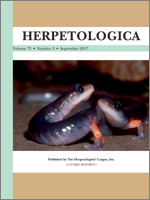Rapid evolution is a hallmark of proteins involved in reproduction. The protein courtship pheromones in plethodontid salamanders are classic examples of such rapidly evolving reproductive proteins, with male pheromones likely coevolving with female receptors to improve reproductive success. Over the past 66 million years of plethodontid evolution, the structure and composition of the male mental gland has evolved with changes in courtship timing and behavior. More than 20 yr of biochemical and molecular studies have provided insight into how multiple gene families have been duplicated, mutated, and co-opted for pheromone roles. Sequencing and mass spectral proteomic analyses have enabled identification and characterization of multiple pheromone families, some with lineage-specific expression. In this review, we provide a phenotypic tango model to better understand male pheromone and female receptor coevolution that has driven the rapid evolution of multiple diverse pheromone families. To offer support for this phenotypic tango model, we review a combination of behavioral, neurophysiological, and structural studies that inform our understanding of the underlying molecular mechanisms of pheromone signaling.
How to translate text using browser tools
1 September 2017
Gene Duplication, Co-option, Structural Evolution, and Phenotypic Tango in the Courtship Pheromones of Plethodontid Salamanders
Damien B. Wilburn,
Stevan J. Arnold,
Lynne D. Houck,
Pamela W. Feldhoff,
Richard C. Feldhoff
ACCESS THE FULL ARTICLE

Herpetologica
Vol. 73 • No. 3
September 2017
Vol. 73 • No. 3
September 2017
biochemistry
Caudata
Protein
sexual selection




